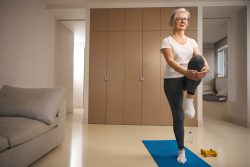 A new study reveals that individuals over 50 who can balance on one leg for 30 seconds, especially on their weaker leg, are showing signs of graceful aging. This simple balance test outperformed traditional measures like hand grip strength, knee strength, and walking stride in assessing healthy aging. Balance is an essential measure because it relies not only on muscle strength but also on visual input. Poor balance increases the risk of falls, regardless of movement, and falls pose significant health risks with potentially serious consequences.
A new study reveals that individuals over 50 who can balance on one leg for 30 seconds, especially on their weaker leg, are showing signs of graceful aging. This simple balance test outperformed traditional measures like hand grip strength, knee strength, and walking stride in assessing healthy aging. Balance is an essential measure because it relies not only on muscle strength but also on visual input. Poor balance increases the risk of falls, regardless of movement, and falls pose significant health risks with potentially serious consequences.
Researchers recruited 40 healthy, individuals over 50 to participate in a series of physical tests that involved walking, balance, grip strength and knee strength. The group was evenly split, with half under 65 and the other half aged 65 and older.
To complete the balance test, participants were asked to stand on one leg for 30 seconds on each side, with the option to hold up the non-standing leg if they preferred, while keeping their eyes open. Participants also performed a test standing on both feet with their eyes open and then closed.
The study revealed a marked decrease in the capacity to maintain balance on one leg with increasing age. Consequently, researchers concluded that this skill is a reliable and gender-neutral indicator of neuromuscular aging in both men and women.
Balance indicates the effectiveness of the body’s systems. Maintaining good balance enables individuals to perform daily activities confidently and securely. Being able to carry out these activities signifies a high quality of life and healthy aging.
To view the original scientific study click below:
Age-related changes in gait, balance, and strength parameters: A cross-sectional study





